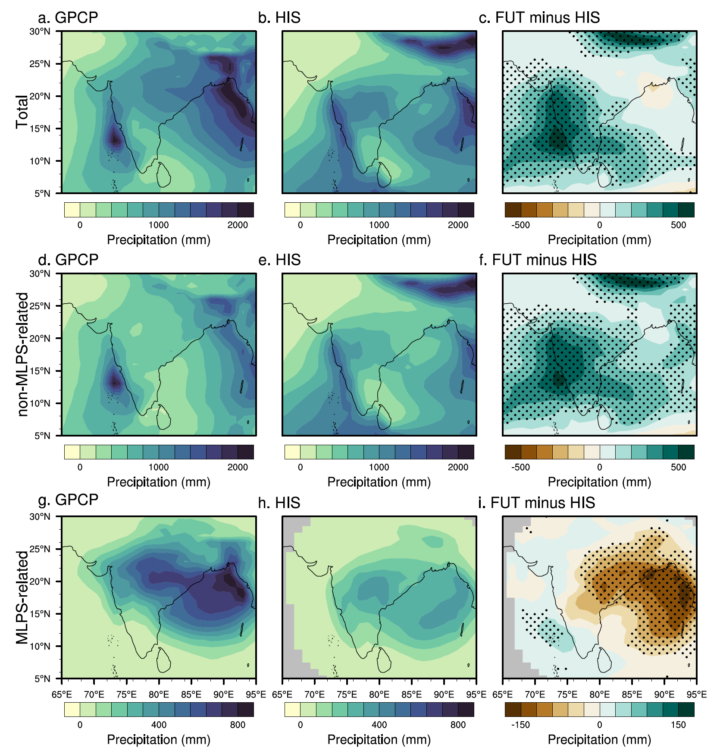Wenhao Dong
My research aims to improve the understanding of past changes and the response to global warming of high-impact weather systems, such as mesoscale convective systems, atmospheric rivers, monsoon low-pressure systems, hurricanes, and midlatitude cyclones.
I approach these questions using satellite observations, reanalysis, general circulation models, global storm-resolving models, and machine learning techniques. As a model developer and atmospheric scientist, I am particularly interested in bridging the gap between our understanding of the Earth system and model simulations.
Recent works
Tropical and North American mesoscale convective systems

Mesoscale convective systems (MCSs) play important roles in the hydrological cycle and global circulation through redistribution of heat, moisture, and momentum in the atmosphere. They are formed when isolated convective events aggregate and grow upscale into large clusters or even superclusters by forming mesoscale circulations. Consequently, MCSs are characterized by distinct structures from scattered or isolated convection, consisting of active convective towers and expansive stratiform regions. Their sizes can reach several hundreds of kilometers with a lifetime ranging from a few hours to a few days. The combination of convective and stratiform precipitation in an MCS makes it a proficient rain producer. Precipitation associated with MCSs is responsible for more than 50% of the total tropical rainfall. And the fraction can even reach up to 90% in selected land regions based on satellite observations. MCSs are often observed in heavily raining areas of the tropics and subtropics as well as mid-latitude continents over prominent baroclinic zones.
We investigate the MCSs over tropical and North America in a series of studies using both satellite observation and high-resolution GCMs developed at the GFDL.
Tropical mean occurrence frequency of mesoscale convective systems➡︎
Relevant Publications:
- Dong, W.*, M. Zhao, Y. Ming, J. Krasting, V. Ramaswamy (2023). Simulation of United States mesoscale convective systems using GFDL’s new high‑resolution general circulation model. J. Climate, 36(19), 6967‑6990.
- Dong, W.*, M. Zhao, Y. Ming. V. Ramaswamy (2022). Significant increase in sea surface temperature at the genesis of tropical mesoscale convective systems. Geophys. Res. Lett., e2022GL101950.
- Dong, W.*, M. Zhao, Y. Ming, V. Ramaswamy (2021). Representation of tropical mesoscale convective systems in a general circulation model: Climatology and response to global warming. J Climate, 34 (14): 5657‑5671.
Recent wetting trend over Taklamakan and Gobi Desert
 The Taklamakan and Gobi Desert (TGD) region has experienced a pronounced increase in summer precipitation, including high-impact extreme events, over recent decades. Despite identifying large-scale circulation changes as a key driver of the wetting trend, understanding the relative contributions of internal variability and external forcings remains limited. Here, we approach this problem by using a hierarchy of numerical simulations, complemented by diverse statistical analysis tools. Our results offer strong evidence that the atmospheric internal variations primarily drive this observed trend. Specifically, recent changes in the North Atlantic Oscillation have redirected the storm track, leading to increased extratropical storms entering TGD and subsequently more precipitation. A clustering analysis further demonstrates that these linkages predominantly operate at the synoptic scale, with larger contributions from large precipitation events. Our analysis highlights the crucial role of internal variability, in addition to anthropogenic forcing, when seeking a comprehensive understanding of future precipitation trends in TGD.
The Taklamakan and Gobi Desert (TGD) region has experienced a pronounced increase in summer precipitation, including high-impact extreme events, over recent decades. Despite identifying large-scale circulation changes as a key driver of the wetting trend, understanding the relative contributions of internal variability and external forcings remains limited. Here, we approach this problem by using a hierarchy of numerical simulations, complemented by diverse statistical analysis tools. Our results offer strong evidence that the atmospheric internal variations primarily drive this observed trend. Specifically, recent changes in the North Atlantic Oscillation have redirected the storm track, leading to increased extratropical storms entering TGD and subsequently more precipitation. A clustering analysis further demonstrates that these linkages predominantly operate at the synoptic scale, with larger contributions from large precipitation events. Our analysis highlights the crucial role of internal variability, in addition to anthropogenic forcing, when seeking a comprehensive understanding of future precipitation trends in TGD.
⬅︎Long-term mean and linear trend of precipitation over TGD
Relevant Publications:
- Dong, W., Y. Ming, Y. Deng, Z. Shen (2024). Recent wetting trend over Taklamakan and Gobi Desert dominated by internal variability, Nat. Commun., 15, 4379.
Atmospheric rivers over the eastern US
 Atmospheric rivers (ARs) play important roles in various extreme weather events across the US. While AR features in western US have been extensively studied, there remains limited understanding of their variability in the eastern US (EUS). Using both observations and a state-of-the-art climate model, we find a significant increase (~10% dec−1) in winter AR frequency in the EUS during the past four decades. This trend is closely linked to recent changes in the Pacific/North America (PNA) teleconnection pattern, accompanied by a poleward shift of the mid-latitude jet stream. We further reveal a strong correlation (R = 0.8; P < 0.001) between interannual variations in AR occurrence and the PNA index. This linkage has been verified in various model simulations. A statistical model, built on this linkage, has proven effective in predicting the AR frequency using the PNA index at both monthly and seasonal scales. These promising results have important implications for addressing concerns related to AR-associated extreme precipitation and flooding in this region.
Atmospheric rivers (ARs) play important roles in various extreme weather events across the US. While AR features in western US have been extensively studied, there remains limited understanding of their variability in the eastern US (EUS). Using both observations and a state-of-the-art climate model, we find a significant increase (~10% dec−1) in winter AR frequency in the EUS during the past four decades. This trend is closely linked to recent changes in the Pacific/North America (PNA) teleconnection pattern, accompanied by a poleward shift of the mid-latitude jet stream. We further reveal a strong correlation (R = 0.8; P < 0.001) between interannual variations in AR occurrence and the PNA index. This linkage has been verified in various model simulations. A statistical model, built on this linkage, has proven effective in predicting the AR frequency using the PNA index at both monthly and seasonal scales. These promising results have important implications for addressing concerns related to AR-associated extreme precipitation and flooding in this region.
Atmospheric river features in the eastern US➡︎
Relevant Publications:
- Dong, W.*, M. Zhao, Z. Tan, V. Ramaswamy (2024). Increasing atmospheric rivers over Eastern US regulated by Pacific/North America pattern. Sci. Adv., 10(4), eadj3325.
Projected changes in Indian monsoon low-pressure system
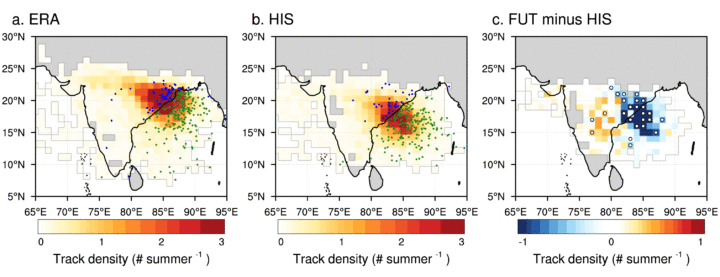
|
Monsoon low-pressure systems (MLPSs) are among the most important synoptic-scale disturbances of the South Asian summer monsoon. Potential changes in their characteristics in a warmer climate would have broad societal impacts. Yet, the findings from a few existing studies are inconclusive. We use the Geophysical Fluid Dynamics Laboratory (GFDL) coupled climate model CM4.0 to examine the projected changes in the simulated MLPS activity under a future emission scenario. It is shown that CM4.0 can skillfully simulate the number, genesis location, intensity, and lifetime of MLPSs. Global warming gives rise to a significant decrease in MLPS activity. An analysis of several large-scale environmental variables, both dynamic and thermodynamic, suggests that the decrease in MLPS activity can be attributed mainly to a reduction in low-level relative vorticity over the core genesis region. The decreased vorticity is consistent with weaker large-scale ascent, which leads to less vorticity production through the stretching term in the vorticity equation. Assuming a fixed radius of influence, the projected reduction in MLPSs would significantly lower the associated precipitation over north-central India, despite an overall increase in mean precipitation.
⬅︎Track density of MLPSs and associated precipitation changes Relevant Publications:
|
Warm-and-dry biases over the central U.S. |
||
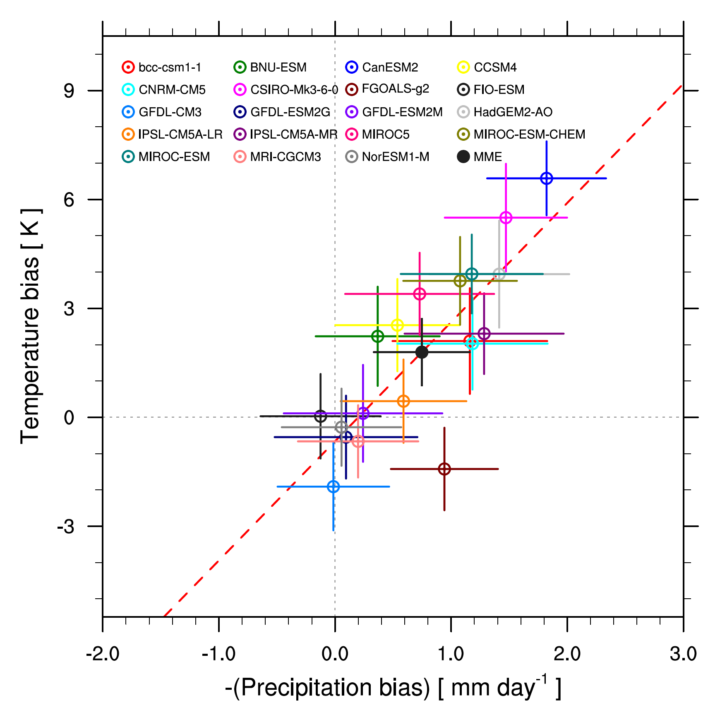 |
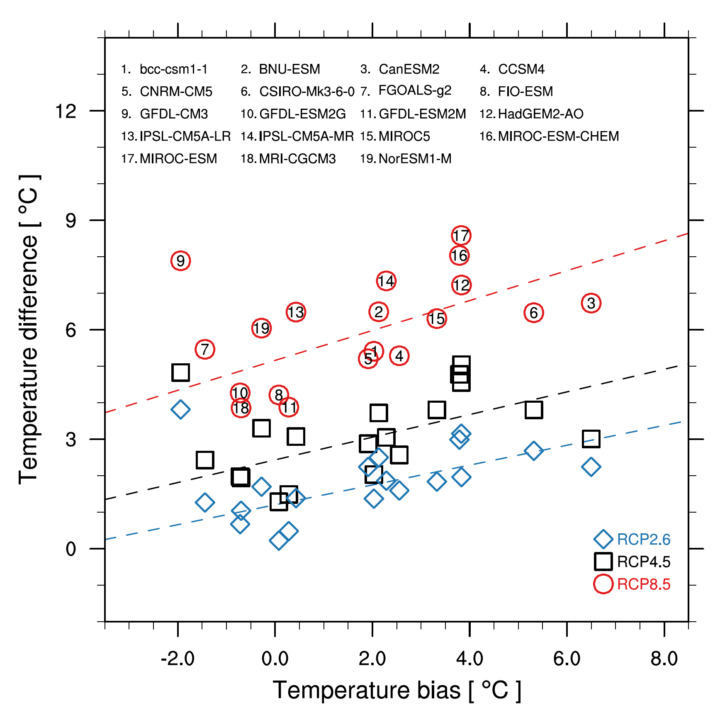 |
Climate models show a conspicuous summer warm and dry bias over the central United States. Using results from 19 climate models in the Coupled Model Intercomparison Project Phase 5 (CMIP5), we report a persistent dependence of warm bias on the dry bias with the precipitation deficit leading the warm bias over this region. The precipitation deficit is associated with the widespread failure of models in capturing strong rainfall events in summer over the central U.S. A robust linear relationship between the projected warming and the present-day warm bias enables us to empirically correct future temperature projections. By the end of the 21st century under the RCP8.5 scenario, the corrections substantially narrow the intermodel spread of the projections and reduce the projected temperature by 2.5 K, resulting mainly from the removal of the warm bias. Instead of a sharp decrease, after this correction, the projected precipitation is nearly neutral for all scenarios. |
| ⬆︎Correspondence between precipitation bias and temperature bias | ⬆︎Dependence of temperature change on temperature bias | Relevant Publications:
|
Up-and-over moisture transport
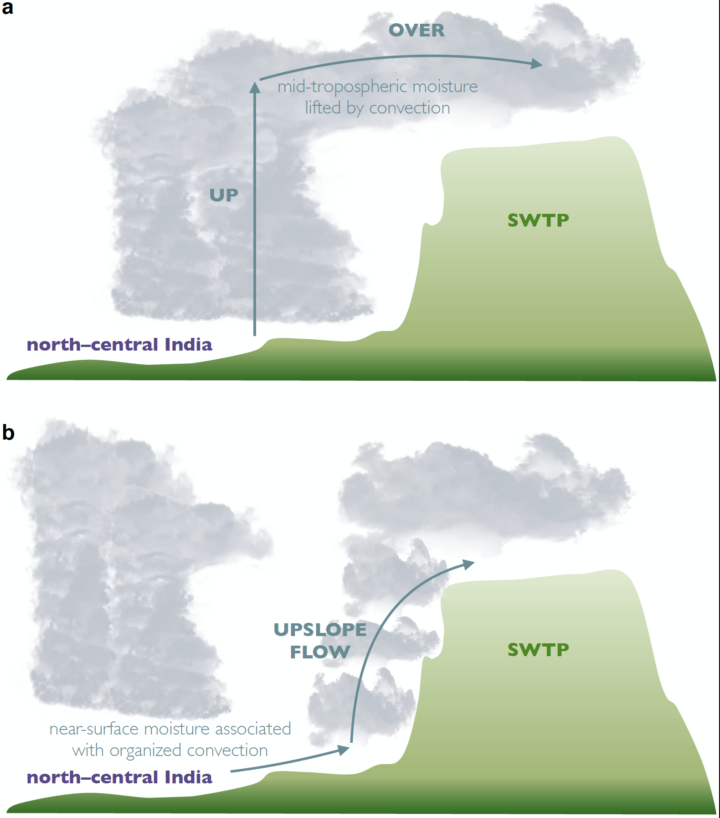
During my Ph.D. study, I am interested in the rainfall connection between the Indian subcontinent and the Tibetan Plateau. We find that more than 60% of total summer rainfall over the southwestern Tibetan Plateau (SWTP) is related to the low-pressure system (LPS) occurrence over the Indian subcontinent. LPSs are associated with a 15% rise in average daily rainfall and a 10% rise in rainy days over the SWTP. We proposed that this relationship is maintained primarily through up‐and‐over transport, in which convectively lifted moisture over the Indian subcontinent is swept over the SWTP by southwesterly winds in the middle troposphere.
LPSs play two roles in supplying up‐and‐over moisture transport. First, these systems elevate large amounts of water vapor and condensed water to the mid-troposphere. Second, the circulations associated with LPSs interact with the background westerlies to induce southwesterly flow in the mid-troposphere, transporting elevated moisture and condensate over the Himalayan Mountains. Our findings indicate that LPSs are influential in extending the northern boundary of the South Asian monsoon system across the Himalayas into the interior of the SWTP. The strength of this connection depends on both LPS characteristics and the configuration of the mid-tropospheric circulation, particularly the prevailing westerlies upstream of the SWTP.
Relevant Publications:
- Dong, W., Y. Lin, J. Wright et al. (2018) Connections between a late summer snowstorm over the southwestern Tibetan Plateau and a concurrent Indian monsoon low pressure system, Geophys. Res. Atmos., 123 (24), 13,676–13,691.
- Dong, W., Y. Lin, J. Wright et al. (2017): Monsoon low pressure systems feed up-and-over moisture transport to the southwestern Tibetan Plateau, Geophys. Res. Atmos., 122, 12140–12151.
- Dong, W., Y. Lin, Wright, Y. Ming et al. (2016): Summer rainfall over the southwestern Tibetan Plateau controlled by deep convection over the Indian subcontinent, Nat. Commun., 7, 10925.



